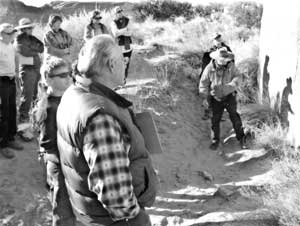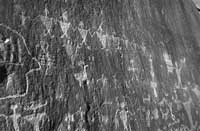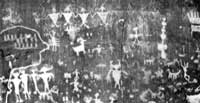
New site stewards visit a rock art panel they help the BLM patrol. |
World-class rock art on public lands in the Moab area have archaeologists, rock-art buffs and federal officials cooperating in efforts to distinguish southeastern Utah with more listings on the National Register of Historic Places.
Dozens of volunteers have received training since 2004 to help locate, document and monitor more than 32,000 reported archaeological sites in the Canyon Country District of the U.S. Bureau of Land Management, which includes the Moab and Monticello field offices.
In Grand County alone 4,200 recorded sites need to be further documented, preserved and protected, and reports of new sites in the area are mounting, according to BLM archaeologists.
“Almost every report we get contains new sites,” BLM archaeologist Joe Tuomey told a sizeable group gathered for the latest training of a civilian corps that is helping to document and patrol the areas. He said rock art by definition is considered eligible for listing on the National Register, by virtue of its archaeological value.
Tuomey and fellow BLM archaeologist Leigh Grench led two days of classroom training followed by field work in mid-November to ready nearly 30 volunteers for on-the-ground monitoring and documenting of rock art and archaeological sites within a 100-mile radius of Moab.
 The BLM “Site Stewardship Program” training, co-sponsored by the Utah Rock Art Research Association (URARA), drew out-of-town and out-of-state volunteers along with a dozen residents of Moab and Castle Valley. The BLM “Site Stewardship Program” training, co-sponsored by the Utah Rock Art Research Association (URARA), drew out-of-town and out-of-state volunteers along with a dozen residents of Moab and Castle Valley.
Also represented in the group were the Grand County Historical Preservation Commission, Anasazi State Park, Utah Museum of Natural History; and working or retired professionals, including museum curators, educators, tour guides and others disciplined or trained in archaeology, paleontology, engineering and law enforcement. Some attended for a refresher course; others were new to the world of rock art but had an interest in preserving remnants of the ancient Indian cultures of this area.
BLM officials were impressed by the turnout, which URARA member Pam Baker termed “huge.” She said the dozens of volunteers trained over the years can make a big difference, especially “for covering sites near roads that are going to get impacts.” Previous site-steward training resulted in documentation and monitoring of more than 60 sites -- a tiny slice of more than 32,000 reported sites in the two-million-acre district.
“Leigh and I really can’t cover two million acres,” Tuomey told participants. “Without your eyes and ears, we’d have a real hard time making sure everything is protected.”
Some sites could date to 9,000 B.C. and may include evidence of an ancient hunting culture that chased mastodons and mammoths from the Plains westward into the Great Basin. Documents provided as part of the training Nov. 14-16 state that “Utah is a veritable treasure house” of rock art and is almost exclusive to other states in terms of the amount of petroglyphs and pictographs ascribed to the Fremont culture (A.D. 400).
The Fremont (named in 1928-29 after the Fremont River) were so distinguished in their artistic expression that their rock art is considered among the finest in the world. Prime examples are seen in Horseshoe Canyon, a detached unit of Canyonlands National Park, which received protection as a designated historic district in the 1970s.
Deep in Horseshoe Canyon, between Green River and Hanksville, is the world-renowned Holy Ghost panel of the Great Gallery -- a site dominated by larger-than-lifesize mineral-based and charcoal stained paintings of anthropomorphic “spirit” figures and animals that studies calculate could be up to 1,600 years old. Whether these artists (or scribes) knew they were developing bonding agents to create paintings that would survive thousands of years of exposure to extreme temperatures, wind and rain remains a mystery -- as do the meanings of the pecked and painted images all over this area.
 Preserving and protecting rock art and other remnants of the ancient cultures so that their artistic expression, mysterious messages on stone, and artifacts remain intact to be studied and explored “diagnostically” is the primary goal of the site-steward program. Preserving and protecting rock art and other remnants of the ancient cultures so that their artistic expression, mysterious messages on stone, and artifacts remain intact to be studied and explored “diagnostically” is the primary goal of the site-steward program.
As archaeologist Hannah Russell explained: “The artifact is nothing without the site. The site is nothing without the diagnostic artifact. The information is gone forever. So it’s important to know it’s not just the ethic (involved in disturbing a site), but you’re destroying the information.”
Ed Maloney, a wildfire-archaeologist expert at the BLM, estimated that 95% of known sites in what he termed “Anasazi country” have been “hit” by looters, but the number of incidents can be curtailed with help of site stewards. “Once the word goes out that you guys are on the job, they’ll go down,” he said.
The Kane Creek and Potash areas west and east of the Colorado River corridor contain significant rock art sites and have come under greater scrutiny from federal law enforcement agencies and now, intensified monitoring under the BLM’s volunteer program. Not surprisingly, significant and distinguished rock art is desirable not only for study by scholars and scientists, but as objects for looters and thieves who actually chisel the art from rock walls, BLM rangers Tyler Fouss and Jason Moore noted.
Utah leads the nation in felony convictions for archaeological violations, said BLM District Manager Shelley Smith. According to Moore, Utah’s courts are getting serious about prosecuting looters, imposing hefty fines and penalties. In addition, anything involved in archaeological vandalism or illegal excavating can be seized, including all gear, weapons and vehicles on-site or used by felons.
“These things are worth a lot of money in some places,” Moore told the group. “These folks that loot these sites are a bad lot. They’re bad people.” Anyone who observes what may be looting is advised to take pictures of license plates, then get out of the area immediately and call the BLM (435-259-2109).
Note: The writer completed the BLM Site Steward training in November. |

 The BLM “Site Stewardship Program” training, co-sponsored by the Utah Rock Art Research Association (URARA), drew out-of-town and out-of-state volunteers along with a dozen residents of Moab and Castle Valley.
The BLM “Site Stewardship Program” training, co-sponsored by the Utah Rock Art Research Association (URARA), drew out-of-town and out-of-state volunteers along with a dozen residents of Moab and Castle Valley.  Preserving and protecting rock art and other remnants of the ancient cultures so that their artistic expression, mysterious messages on stone, and artifacts remain intact to be studied and explored “diagnostically” is the primary goal of the site-steward program.
Preserving and protecting rock art and other remnants of the ancient cultures so that their artistic expression, mysterious messages on stone, and artifacts remain intact to be studied and explored “diagnostically” is the primary goal of the site-steward program.